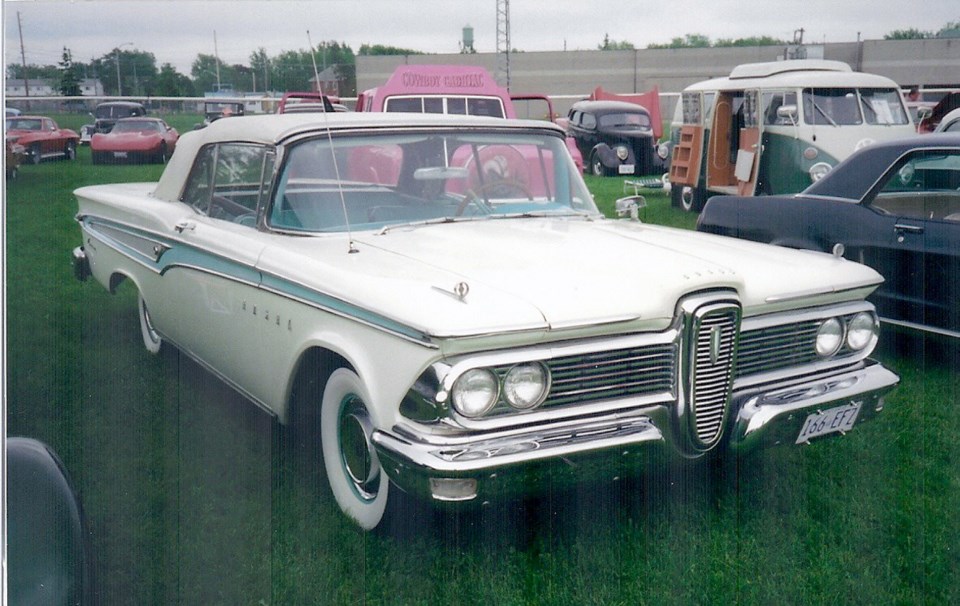No automotive name in modern times is cited more often as an example of failure than Edsel. In earlier times, perhaps the 1934-1937 Chrysler/DeSoto Airflow models came closest.
In a way, the Edsel’s roots traced back to the 1920s, when General Motors’ legendary president, Alfred P. Sloan, Jr. cleverly crafted a hierarchy of cars from the entry-level Chevrolet to the prestigious Cadillac he called “a car for every purse and purpose.”
Edsel Ford, the original Henry Ford’s only son who became Ford Motor Co.’s president in 1919, marvelled at GM’s strategy. Under Henry’s iron rule, Ford had been locked into a one-model strategy since 1908. And that legendary Model T Ford was becoming obsolete by the mid-1920s.
To expand its offerings, in 1922 Edsel had Ford purchase the failing luxury-car maker Lincoln Motor Co. to give Ford a luxury car.
With the 1930s Depression severely depleting expensive luxury car sales, Lincoln introduced the more affordable 1936 Lincoln Zephyr to fill out the line. Offerings were increased further in 1939 with the addition of the “deluxe Ford” Mercury, which was very well received.
After the Second World War, Ford’s able new management team aspired to go model for model with GM and Chrysler. It saw a need for more mid-market strength to compete with cars such as Pontiac, Oldsmobile, Buick, Dodge and De Soto. This was the genesis of the “E-car,” as it was coded.
The signs looked good, although some company officials questioned the need for another medium-priced car. Ford Motor Co. already had the Mercury, and in Canada, a Mercury clone called the Monarch. But optimism was strong, reinforced by Detroit’s best sales year in history in 1955.
To demonstrate its seriousness about the E-car project, Ford would establish a separate new division for it. First-year production was confidently projected at 200,000 in five plants. Although it wouldn’t appear until the fall of 1957, public announcements began in August 1956.
Ford launched an extensive name-the-car program, and among about 8,000 entries came these from New York poet Marriane Moore: Resilient Bullet, Mongoose Civique, Varsity Stroke and Utopian Turtletop.
Among the finalists were Ranger, Pacer, Corsair and Citation. Though not considered expansive enough for a brand name, they would be used as series designations.
The Edsel name was finally raised again (Edsel Ford had died in 1943). Although vetoed earlier by the Ford family, they were finally persuaded. The new car became the Edsel.
Meanwhile, the car market was undergoing an evolution. Fords, Chevrolets and Plymouths were growing large enough to encroach on the medium-priced market. Sales of Chrysler’s 1957 De Soto were off more than 50 per cent and it would disappear four years later. Mercury and Dodge were suffering, and Buick and Oldsmobile were also down significantly.
To makes matters worse, the 1958 Edsel arrived in September 1957 with an economic recession in progress. It was a far cry from the optimism of 1954, when it was conceived.
The Edsel came in four series: Ranger and Pacer using a Ford chassis, and the more upscale Corsair and Citation with Mercury underpinnings. In keeping with its more luxurious pretentions, the Edsel came with V-8 engines only: 5.9 litre (361 cu in.) for the Ranger and Pacer, and 6.6 litre (401 cu in.) in Corsair and Citation.
Then there was the styling. Although in retrospect the Edsel’s general styling was tasteful enough compared with chrome-laden GM cars, most observers didn’t get past a front end dominated by an oblong vertical opening with its egg-shaped insert.
It was quickly dubbed a “horse collar,” or even worse, “an Oldsmobile sucking a lemon.”
Other factors didn’t thrill buyers either, like the sometimes-troublesome “Teletouch” transmission selector buttons in the steering-wheel hub.
And Edsel suffered some quality problems, because it lacked its own production facility. It was inserted into Ford and Mercury assembly lines among the regular models, and workers resented the misfit.
The result of all this was that instead of the hoped-for minimum 100,000 sales, only 63,110 1958 Edsels were sold.
In an attempt to improve for 1959, the Pacer and Citation series were dropped, leaving only the Ranger and Corsair. The horse-collar grille was softened, and a six joined the V-8s. But there was no turning it around; model-year sales declined to 44,891.
Although a restyling was done for 1960, replacing the ill-fated grille with a split one, the Edsel was really finished. Production ended on Nov. 19, 1959, after only 2,846 1960 models had been built.
Ford’s Edsel had been caught in the crossfire of factors: a declining medium-car market; an economic recession; some quality problems; and generally unacceptable styling. Since the Edsel couldn’t overcome these forces, its name is inextricably linked with failure.



